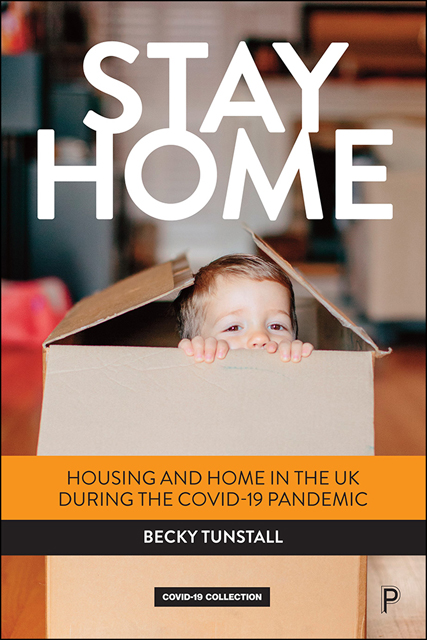Book contents
- Frontmatter
- Contents
- List of figures, tables and photos
- Acknowledgements
- 1 COVID-19, housing and home
- 2 UK households and homes before the pandemic
- 3 The pandemic and pandemic policy in the UK
- 4 People, households and time at home in the pandemic
- 5 The role of household and home in COVID-19 infection and death
- 6 Being vulnerable or ill at home in the pandemic
- 7 The impact of COVID-19 and COVID-19 policy on incomes, housing costs and housing security
- 8 The impact of COVID-19 and COVID-19 policy on the housing market
- 9 Summary and conclusions
- Appendix: The data from people aged 19, 31, 50, 62 and 74
- Notes
- References
- Index
6 - Being vulnerable or ill at home in the pandemic
Published online by Cambridge University Press: 20 June 2023
- Frontmatter
- Contents
- List of figures, tables and photos
- Acknowledgements
- 1 COVID-19, housing and home
- 2 UK households and homes before the pandemic
- 3 The pandemic and pandemic policy in the UK
- 4 People, households and time at home in the pandemic
- 5 The role of household and home in COVID-19 infection and death
- 6 Being vulnerable or ill at home in the pandemic
- 7 The impact of COVID-19 and COVID-19 policy on incomes, housing costs and housing security
- 8 The impact of COVID-19 and COVID-19 policy on the housing market
- 9 Summary and conclusions
- Appendix: The data from people aged 19, 31, 50, 62 and 74
- Notes
- References
- Index
Summary
This chapter focuses on being vulnerable to COVID-19 infection, other physical or mental health problems, or because of the need for care and support. Readers requiring detailed analysis of vulnerability to health-harming behaviours or to domestic abuse are advised to turn to specialised sources.
Shielding and isolating at home
Introduction
‘Shielding’ and ‘isolating’ were the strictest forms of staying home (see Chapter 3). Millions of people who were particularly vulnerable to serious illness and death if they become infected were asked to shield, initially partly to protect the NHS from having too many serious cases, and latterly for their own protection. Millions more with COVID-19 or suspected of having it were asked to isolate in order to protect others, primarily people outside their household.
The high COVID-19 risk and isolation of vulnerable people in care homes during the pandemic has been widely acknowledged. However, the situation of vulnerable people shielding at home has been less recognised. Shielding alone amounted to prolonged solitary confinement, which is prohibited by the United Nations. Shielding and isolating with others was risky. Shielders and isolators became new types of dependent people, and most relied on family and friends for support.
Many people did not have the right homes for shielding and isolating. Pre-existing inequalities in housing space (see Chapter 2) worsened during the pandemic (see Chapter 4), and became more dangerous, because they affected the risk of transmission at home (see Chapter 5). People on low incomes, of minority ethnicity and tenants were disadvantaged. Shielding and isolating had personal and financial costs, which were not recognised or compensated fully or (in the case of shielders) at all. Inequalities reduced the effectiveness of shielding and isolating, and meant that some infections and deaths occurred which could have been avoided.
People at most risk from COVID-19
In March 2020, the chief medical officers of the four nations of the UK drew up a list, based on what was known at the time, of conditions likely to make people ‘clinically extremely vulnerable’ (CEV) to COVID-19 infection or severe disease. These conditions included reduced immunity due to cancer treatment, cystic fibrosis, severe asthma and severe chronic obstructive pulmonary disease.
- Type
- Chapter
- Information
- Stay HomeHousing and Home in the UK during the COVID-19 Pandemic, pp. 101 - 135Publisher: Bristol University PressPrint publication year: 2022



